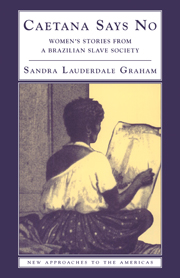Caetana Says No: Patriarchy Confounded
Published online by Cambridge University Press: 05 February 2015
Summary
In the weeks preceding the wedding the usual Catholic preparations were made: Papers were signed, fees paid, banns posted. Then on a spring day in October 1835, on the plantation Rio Claro in the Province of São Paulo, a priest, who had journeyed from the nearby village of Santo Antônio de Paraibuna, prepared to celebrate mass in the plantation chapel. The benches arranged, he readied the altar with its candlesticks that stood four hands high, its missal, bell, and chalice, and placed the holy vestments over his own plain black cassock. Two witnesses stood ready, while the groom waited at the chapel door. The young bride, slow to dress in her best, at last presented herself for the ceremony. The mass said and the matrimonial blessing given, the priest left the plantation and returned home to the village.
This pleasant but apparently unremarkable scene discloses a slave wedding, and with this fact it captures our attention. The bride, Caetana, perhaps seventeen years old, and the groom, Custódio, in his mid-twenties, were fellow slaves, or parceiros, a term that acknowledged them as companions belonging to a common master, the human property of Captain Luís Mariano de Tolosa, owner of Rio Claro. A slave marriage blessed by the church and made legally binding would seem an unusually gracious ending to a tale of slave love.
- Type
- Chapter
- Information
- Caetana Says NoWomen's Stories from a Brazilian Slave Society, pp. 1 - 74Publisher: Cambridge University PressPrint publication year: 2002



